|
The
|
THE BURGENLAND BUNCH NEWS - No. 267 June 30, 2016, © 2016 by The Burgenland Bunch All rights reserved. Permission to copy excerpts granted if credit is provided. Editor: Thomas Steichen (email: tj.steichen@comcast.net) Archives at: BB Newsletter Index Our 20th Year. The Burgenland Bunch Newsletter is issued monthly online. It was founded by Gerald Berghold (who retired from the BB in the Summer of 2008 and died in August 2008). |
| Current Status Of The BB: * Members: 2448 * Surname Entries: 7871 * Query Board Entries: 5544 * Staff Members: 16 |
|
1) THE PRESIDENT'S CORNER (by Tom Steichen)  After
the bits and pieces here in my "Corner," I begin the main articles in Article 2 with an interesting map graphic about the
Anschluß of West Ungarn to Austria after WW-I. It helps show why the new Austria/Hungary border was set where it
is and I thought it was an opportunity to talk about this again. After
the bits and pieces here in my "Corner," I begin the main articles in Article 2 with an interesting map graphic about the
Anschluß of West Ungarn to Austria after WW-I. It helps show why the new Austria/Hungary border was set where it
is and I thought it was an opportunity to talk about this again.Article 3 finishes the short sequence of three articles that provide Translations of Long-Form Hungarian Civil Records, those used from 1895 until 1906. The third and final article will be for an example Marriage Record. Article 4 discusses Edelserpentin, a gem-quality mineral found near Bernstein im Burgenland, and the museum that celebrates it. The remaining articles are our standard sections: Historical Newsletter Articles, and the Ethnic Events and Emigrant Obituaries sections. New York Gathering of BB Editors Santana, Paukowits and Steichen: I'm pleased to report that I was able to get together with BB Editors Johnny Santana and Frank Paukowits on Sunday, May 29th. My wife, Lois, and I were visiting our son in New York City and we were also able to schedule an evening with Johnny, Frank and Frank's wife Elsie. 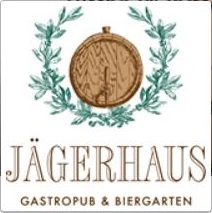 Better
yet, Frank and Johnny scheduled us for dinner at the Jägerhaus Gastropub & Biergarten in Whitestone, Queens, NY, a
relatively new restaurant that is co-owned by BB member Bill Gross and describes itself as "a collaborative effort that
brings a contemporary twist to traditional German & Austrian cuisine." However, I also noted a Burgenland village sign
displayed prominently in the main dining room, a nod to Bill's roots. Better
yet, Frank and Johnny scheduled us for dinner at the Jägerhaus Gastropub & Biergarten in Whitestone, Queens, NY, a
relatively new restaurant that is co-owned by BB member Bill Gross and describes itself as "a collaborative effort that
brings a contemporary twist to traditional German & Austrian cuisine." However, I also noted a Burgenland village sign
displayed prominently in the main dining room, a nod to Bill's roots.Although it was a warm May evening, the Jägerhaus' beers were wondrously cold, so the evening 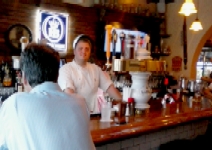 started
very well. Further, the on-draft selection of German beers was outstanding. The food... well, every plate was bare when we
were done and every face had a very satisfied look. Nonetheless, the desert selections looked so good that we could not
resist... yumm, again! My congratulations to Bill for his part in this excellent establishment; I can unconditionally
recommend it! started
very well. Further, the on-draft selection of German beers was outstanding. The food... well, every plate was bare when we
were done and every face had a very satisfied look. Nonetheless, the desert selections looked so good that we could not
resist... yumm, again! My congratulations to Bill for his part in this excellent establishment; I can unconditionally
recommend it!As for our BB Editors meeting, it was much more a social than business gathering, being the first time Frank and I had met Johnny. I know we talked a little about "business" but I much more recall the evening's fellowship and the opportunity to meet Johnny. He is an excellent storyteller and a pleasure to spend an evening with. As always, it was good to get together with Frank and Elsie again, something Lois and I have had the pleasure of doing a number of times... but we'll look forward to the next time too. 17 Migrants Found in Van at Hungarian Border in June: Austrian police in Burgenland  reported
that on June 12th they found 17 migrants in a van entering the country from Hungary. The vehicle was Romanian-registered and
was stopped for a routine border check on the A4 highway at Nickelsdorf (in northern Burgenland). reported
that on June 12th they found 17 migrants in a van entering the country from Hungary. The vehicle was Romanian-registered and
was stopped for a routine border check on the A4 highway at Nickelsdorf (in northern Burgenland). Thus it seems that the problem of illegal—and dangerous—immigration continues. BG 60th Anniversary Schedule: Friday, June 24: Press conference at the Emigrant Museum in Güssing. Saturday, July 2: Inauguration of the festival in Bad Tatzmannsdorf with the premiere of the play "Hiaz geht's aufwärts" by Edi Nicka about the Amerika Auswanderung. Friday, July 8: Heimatabend in the castle in Stegersbach with the "dance violinists" and Burgenland music (including Bobby Strauch). Anniversary of the twin cities, Northampton and Stegersbach. Saturday, July 9: Laying of a wreath at the grave of the late President Julius Gmoser in Mogersdorf. Extended board meeting with participants from abroad in Stegersbach. Sunday, July 10: 9:00 - Mass with Bishop Zsifkovics in Güssing. 11:00 - Brunch in the main square in Güssing with live broadcast on the radio. Anniversary: 20 years "Güssing - City of Overseas Burgenländer". 14:00 - Picnic in Moschendorf with Governor Niessl ceremony around 15:00. Tuesday, July 12: Miss Burgenland, New York day and a trip for the delegation and visitors to Eisenstadt for a reception with Governor Niessl and Bishop Zsifkovics. Evening: Weintaufe (wine baptism) in the name of "Miss Burgenland, New York" in Moschendorf. My personal experience on the 27th was that the site was never down (at least the parts I was using). I'll continue to check it to see if I note any changes... and please let me know if you detect any.  Update
for book "The Burgenländer Emigration to America": Here is this month's update on purchases of the English issue of
the 3rd edition of Dr. Walter Dujmovits' book "Die Amerika-Wanderung Der Burgenländer." Update
for book "The Burgenländer Emigration to America": Here is this month's update on purchases of the English issue of
the 3rd edition of Dr. Walter Dujmovits' book "Die Amerika-Wanderung Der Burgenländer."Current total sales are 1064 copies, as interested people purchased 5 more books during this past month. As always, the book remains available for online purchase at a list price of $7.41 (which is the production charge for the book, as we purposely choose not to make a profit so we can avoid dealing with the income tax consequences and so you can obtain the book at as low a cost as possible!), plus tax & shipping. See the BB homepage for a link to the information / ordering page and for any current discounts (and there is at least one discount on price or shipping available most of the time... if not, wait a few days and there will be one!).  Burgenland
Recipes: Burgenland
Recipes: Sorry, I've used up all of the Burgenland-related recipes from my current source, thus Burgenland Recipes will take a temporary respite. Please consider sharing your favorite Burgenland recipes or recipe books with me so I can share them with the readership. Thanks! Cartoon of the Month: 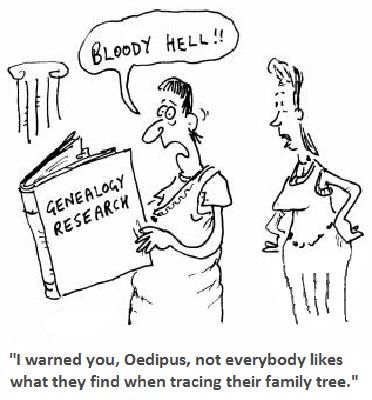 |
2) THE EASTERN BORDER OF BURGENLAND We've talked before about the various forces that led to the final placement of the eastern border of Burgenland after WW-I, however, I found the following extremely well-done graphic that makes it easy to see the issues that made that placement difficult ...so I wish to revisit the subject. 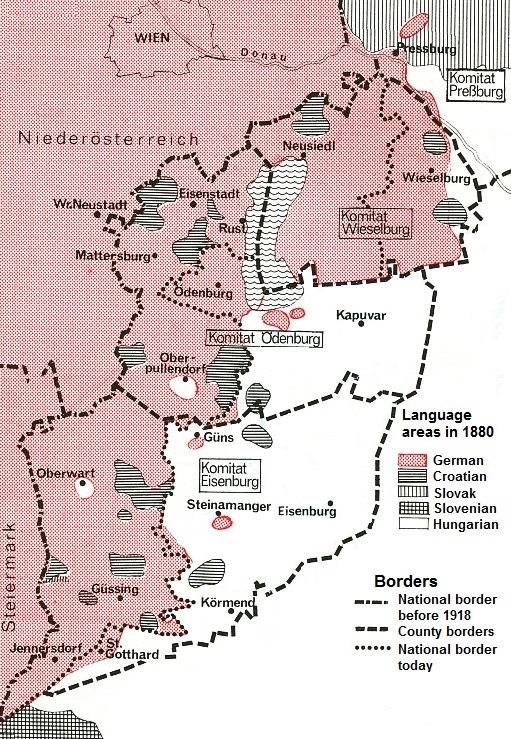 Adapted from: http://austria-forum.org/af/Wissenssammlungen/Geschichtsatlas/Burgenland zu Österreich As you likely know, Burgenland was provisionally admitted to Austria on January 25, 1921, but it would not be until March 10, 1923, that the final border was agreed to (begrudgingly) by all parties. The initial border plan (from 1919) included substantially more people and territory to be transferred to Austria than what eventually changed countries. The main purpose of the redrawing of borders was to place "like people" with "like," basically along the ethnic splits, with primary language being the key to defining ethnicity. Thus the predominantly German-speaking areas were to be added to Austria, with the predominantly Hungarian-speaking areas remaining in Hungary. The embedded Croatian-speaking areas in West Hungary were a complicating factor but not a major consideration. Likewise, the Slovak areas to the north and the Slovenian areas to the south were fairly well-defined and the divisions relatively easy to make. I'll start my discussion with some overall comments and then work my way from north to south to discuss the issues affecting placement of the border in various locations. The first thing that should be evident from the graphic above was the source of the name Burgenland. As you can see, the German-speaking areas under consideration for transfer to Austria (shown in pink in the graphic) were in four Hungarian counties that were adjacent to the old Austro-Hungarian border. The German names for these counties (Komitats) were Preßburg, Wieselburg, Ödenburg and Eisenburg. Thus an obvious and early choice for the new Austrian territory was Vierburgenland (roughly, Four "Burgs" Land). As we will see below, one of the first things that happened during the determination of the new border was that the Preßburg County areas were removed from transfer consideration. Thus the name quickly morphed to Dreiburgenland (Drei = Three) and then to just Burgenland. So, though the German word Burg means castle, it was not the castles in Burgenland that led to its name, it was the "burg" in the county names that was responsible. 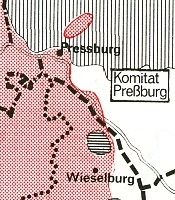 Now
I will address the Preßburg (Pozsony) County areas. To the right is a clip from the original graphic that
targets the Preßburg area. Here, the black vertical hatching indicates Slovak-speaking areas and the small horizontal
hatched area is a Croatian-speaking zone, whereas the German-speaking areas are in red and the Hungarian-speaking areas are
in white. The heavy black dashed lines indicate County borders, whereas the lighter dash-dot lines indicates the old
Austro-Hungarian border (which also is defined by a short stretch of the Danube River). The dotted line represents the final
eastern Burgenland border. Now
I will address the Preßburg (Pozsony) County areas. To the right is a clip from the original graphic that
targets the Preßburg area. Here, the black vertical hatching indicates Slovak-speaking areas and the small horizontal
hatched area is a Croatian-speaking zone, whereas the German-speaking areas are in red and the Hungarian-speaking areas are
in white. The heavy black dashed lines indicate County borders, whereas the lighter dash-dot lines indicates the old
Austro-Hungarian border (which also is defined by a short stretch of the Danube River). The dotted line represents the final
eastern Burgenland border. If you look closely, you will see that part of Preßburg County extended to the southwest of the Danube River. Likewise, the German-speaking areas extended into areas northeast of the Danube and included the city of Preßburg (Pozsony in Hungarian; now Bratislava, Slovakia) and there was a detached German-speaking area beyond that. From the 13th century until the 19th century, German-speakers were the dominant ethnic group (75%) in the city of Preßburg, with Slovaks as the largest minority (18%). However, after the Compromise of 1867, the Hungarian government encouraged Magyarization and, by the end of World War I, Preßburg was made up mainly of German-speakers (42%) and Hungarian-speakers (40%), with Slovaks (15%) still the largest minority. Nonetheless, there were strong historical reasons "justifying" control by each of the ethnic groups. Despite having a predominant German ethnic heritage and being surrounded by a German-speaking area, the city was the capital of the Kingdom of Hungary from 1536 to 1783, thus validating a Hungarian claim. However, it was also the obvious capital for an independent Slovakia, being the largest city in the Slovak-speaking territory and home to many Slovak historical figures. Regardless, the decision was made in 1918 that the Slovaks would be joined with the Czechs in a country called Czechoslovakia; there would be no independent Slovakia and Preßburg would become merely an administrative district capital within the combined country. The immediate reaction by Preßburg's dominant Hungarian and German population was to try to prevent the Czechoslovak annexation by declaring it a free city. However, the Czechoslovak Legions occupied the city on January 1, 1919, and forced it to become part of Czechoslovakia. The city then became the unofficial seat of Slovakia's political organs and organizations. It would not be until 1939 that the first independent Slovak Republic was declared, with Bratislava the capital. However, the end of WW-II caused the Slovak Republic to be reunited with the Czechs and the city would again wait, until 1968, when it became capital of the Slovak Socialist Republic as one of the two states of a federalized Czechoslovakia. Even then, it took until 1993 for the city to became the capital of the newly-formed and truly independent Slovak Republic. Having made the decision about Preßburg, the rest of the German-speaking areas within Preßburg County were taken out of consideration; these areas would not become part of Burgenland. 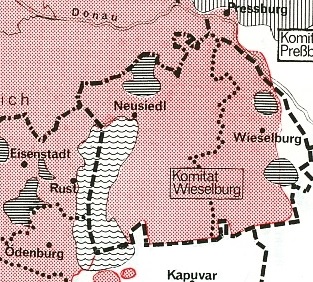 I'll
now move down into the Wieselburg (Moson) County areas. The overriding factor controlling the fate of the
German-speaking areas of Wieselburg County were the placement of the railroads heading south out of Preßburg. One main line
headed southwest and divided around the Neusiedlersee, with one branch looping over the north end of the See
and going down the west side to Ödenburg (Sopron), and the other branch passing through the small villages on the east side
of the See before both passed back into Hungarian-speaking areas on the south end of the See. The other main
line took a slightly more eastern route, traveling essentially "straight" south from Preßburg. You can approximate its
location by noting that it is within a mile or two east of the line that eventually became the new Burgenland border in
Wieselburg County. I'll
now move down into the Wieselburg (Moson) County areas. The overriding factor controlling the fate of the
German-speaking areas of Wieselburg County were the placement of the railroads heading south out of Preßburg. One main line
headed southwest and divided around the Neusiedlersee, with one branch looping over the north end of the See
and going down the west side to Ödenburg (Sopron), and the other branch passing through the small villages on the east side
of the See before both passed back into Hungarian-speaking areas on the south end of the See. The other main
line took a slightly more eastern route, traveling essentially "straight" south from Preßburg. You can approximate its
location by noting that it is within a mile or two east of the line that eventually became the new Burgenland border in
Wieselburg County.The Hungarians did not want both lines to be in Austrian territory, as that would allow Austria to sever travel to the south from Preßburg into Hungarian regions should Austria and Hungary have a dispute. Likewise, the Czechoslovaks wanted neither Austria or Hungary to control all travel south from their territory. Further, they argued for a Slavic "corridor" running between the West Slavs of Czechoslovakia and Poland in the north to the South Slavs in Slovenia, Croatia, Bosnia, Serbia, Montenegro, Macedonia and Bulgaria. A region (much like Burgenland) between the new territories of Austria and of Hungary being the "obvious" location for such a corridor. Ultimately, the corridor idea was ignored but the railroad considerations were not. Thus a large area of German-speakers within Wieselburg County (i.e., the Heideboden) remained in Hungary and the new national border largely followed along the village hotter limits of the villages immediately to the west of the eastern rail line. 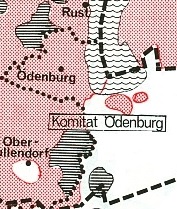 Ödenburg
(Sopron) County areas. The likely most well-known factor affecting the division of Ödenburg County between Austria
and Hungary (and possible affecting the overall formation of Burgenland) was the Sopron plebiscite. With the
exception of two embedded German-speaking areas just to the south of the Neusiedlersee and the Hungarian-speaking
area around Oberpullendorf, the ethnic divide was rather straightforward, with Germans to the west and Hungarians to the
east... yet the district and town of Sopron (Ödenburg) became the spark that nearly blew up the formation of Burgenland. Ödenburg
(Sopron) County areas. The likely most well-known factor affecting the division of Ödenburg County between Austria
and Hungary (and possible affecting the overall formation of Burgenland) was the Sopron plebiscite. With the
exception of two embedded German-speaking areas just to the south of the Neusiedlersee and the Hungarian-speaking
area around Oberpullendorf, the ethnic divide was rather straightforward, with Germans to the west and Hungarians to the
east... yet the district and town of Sopron (Ödenburg) became the spark that nearly blew up the formation of Burgenland. Sopron was the largest and most central of the bigger German-speaking villages; it was the obvious choice for the capital of the new Burgenland. But it also was an ancient center of Hungarian politics and Magyar culture, and its inhabitants, German-speaking or not, did not readily identify with Austria and its Hapsburg past. Sopron quickly became the "poster child" for the Hungarian objections over loss of territory to Austria. The solution was a plebiscite allowing the residents to vote on which country they wanted to be part of. Despite arguments that the Hungarians fixed the vote, the reality is the decision likely was not altered by that manipulation... it was only that the size of the margin was somewhat greater than it might have been otherwise. Less well-known was that a small region in the Ödenburg district—the area around the village of Brennberg / Brenbergbánya—was the last “point of dispute” in the setting of the new Austrian/Hungarian border in 1919-1923 period (it actually took that long to finalize everything). And, despite being “finalized” in 1923, arguments over Brennberg still continued until 1925. Why? Its name implies the reason: “Brennberg” in German is “burning mountain” and “bánya” in Hungarian is “mine.” Brennbergbánya was home to an old and valuable underground coal mine (opened in 1785 and the deepest coal mine in Hungary)—and both sides wanted it. What complicated matters was that the active coal veins and the working mining shafts ran under the border into what was to be new Austrian territory (Brennberg is located, on the map above, along the new border approximately below the "d" in word Ödenburg). It took a separate international agreement to settle that issue (granting all mined coal to Hungary). Although the Hungarians retained control of the village and mine, the village would once again become distinguished at the end of WW-II... while all other ethnic Germans in the Sopron area were being deported and replaced by ethnic Hungarians, the German miners of Brennberg were exempt... the economic value of their skills and labor trumped the desire to ethnic cleanse the area. Nonetheless, by 1952 the mine closed, as it was no longer economically efficient, and, during the Hungarian Uprising in 1956, Brennberg was a natural route across the border (for both Brennbergers and others) because of its wooded, rugged terrain and because the Germans of Brennberg retained family contacts on the other side of the adjacent Austrian border to help them cross. Though not tied to the setting of the border, I'll note that the villages to Brennberg's immediate north-northwest, Ágfalva (Agendorf, in German), and Sopronbánfalva (Wandorf), which is now incorporated into the town of Sopron, have extensive webpages documenting the almost-total forced deportations of ethnic Germans after WW-II; they stand in stark contrast to Brennberg's fate. The pages are in German and can be reached from webpage: www.oedenburgerland.de. Just click the appropriate village name on the right. Note that the underlying deportation data is map-driven based on the village house plan (i.e., map). Links to these pages have also been added to the BB's Emigration/Deportation page. Further south in old Ödenburg County, the intended border was a little straighter than what was finally demarked. This arose mostly because Austria and Hungary traded villages or parts of villages back and forth for various reasons: for example, particular villages preferred one country over another, the Hungarian nobility in the area generally preferred that their properties remain in Hungary, and because of economic considerations affecting the bigger cities that were to remain in Hungary. Thus, some of the Austrian land gains for villages Nikitsch and Lutzmannsburg (along the eastern edge of what became district Oberpullendorf) were in trade for land to Hungary near St. Gotthárd. Likewise, the village of Olmod (Bleigraben) was traded back to Hungary for the combined village Rattersdorf-Liebing, as Rattersdorf held a key road connecting southern and middle Burgenland. However, some of the Rattersdorf forest land stayed in Hungary, as Prince Eszterházy wanted as much as his Rattersdorf land as possible to remain Hungarian (the loss of Olmod and the forest land is why the map shows a German-speaking area along the bottom edge of Ödenburg County that remained in Hungary). 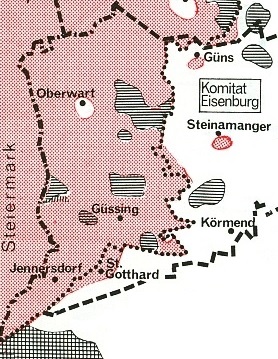 The
predominant principle that drove the positioning of the new border in the Eisenburg (Vas) County area was that
of self-determination, especially in the lower Pinka valley. In fact, this occurred even though it severed roadways and
rivers and divided many villages from their longstanding market cities. Burghardt, in his book, "The Political Geography
of Burgenland," reports that the "in the space of 13 miles, the Pinka stream was cut seven times" and that "after the
line was finally established, only the southernmost Gemeinde in the valley had road connections with its own country." The
predominant principle that drove the positioning of the new border in the Eisenburg (Vas) County area was that
of self-determination, especially in the lower Pinka valley. In fact, this occurred even though it severed roadways and
rivers and divided many villages from their longstanding market cities. Burghardt, in his book, "The Political Geography
of Burgenland," reports that the "in the space of 13 miles, the Pinka stream was cut seven times" and that "after the
line was finally established, only the southernmost Gemeinde in the valley had road connections with its own country."
Some of this back-and-forth in setting the border was a direct result of the will of the people (or their leadership); but it was made worse by subsequent land swaps between the governments. Német-Keresztes and Magyar-Keresztes (now joined as Vas-Keresztes / Großdorf) were both German-speaking. Much of the land in Német-Keresztes belonged to a Bavarian prince who wished to have his holdings remain in Hungary. Likewise, most of the land in Magyar-Keresztes belonged to the Hungarian monastery of Ják, whose clergy was pro-Hungarian, and this village also opted for Hungary, despite language. Eisenberg and Deutsch-Schützen were German-speaking and chose Austria, whereas Horvat Lövo was Croatian and chose Hungary. According to Burghardt and also Robert Unger (in his book, Twenty Five Years of my Life in my Homeland), Pornóapáti was German but, under the direction of its pastor, declared itself for Hungary. More likely, says BB staff member Wilhelm Schmidt, the attention paid to the border commission by a local large estate holder, Prince Franz of Bavaria, and the bishop, Janos Mikes, an ardent Hungarian patriot who did not want to lose any part of his diocese, swayed the decision to keep Pornóapáti in Hungary. Ober-Bildein, Unter-Bildein, Eberau, Gaas, and Moschendorf were all German and demonstrated for Austria. Pinkamindszent was Magyar and chose Hungary. As the boundary was originally drawn, Szentpéterfa was included in Austria while Luising was in Hungary, However, the people of Luising asked for union with Austria, as they were German and had always gone to adjacent Hagensdorf to school and church; the Croatian village of Szentpéterfa asked to be reunited with Hungary; and the two governments arranged the exchange, thus creating two additional cross-river salients. When the border was finally set, the Austrian side had to build a new north-south road system in the Pinka valley, as the prior valley road was severed multiple times by the new border. On the Hungarian side, a new north-south road in the valley made no sense, as the northern villages oriented toward Szombathely while the southern villages oriented toward Körmend. Szentpéterfa became totally isolated and a new road through forest had to be built to connect it to Hungary. As mentioned above, some of the German-speaking area near St. Gotthárd was given back to Hungary in trade for land near Nikitsch and Lutzmannsburg. However, this transfer cut off the only remaining road between the Lafnitz and Raab river valleys (the main road, south of the Raab, went through St. Gotthárd but there was a minor road north of the Raab that carried local traffic between Mogersdorf and Deutsch Minihof and was intended to be in Austria). After objections by the locals about the loss of their road, Hungary agreed to build a new road on the Austrian side of the line to replace it (though it was not completed until 1926). Because the new, adjusted border pushed up against the ridge dividing the two river valleys, the Hungarians were forced to build the new Austrian road immediately adjacent to the border, making the road impossible for the Austrians to defend (if ever necessary) and, after the Iron Curtain went up, within yards of the barb wire and mines of the Communist border. Looking at the map it seems apparent that St. Gotthárd and its German-speaking environs should have transferred wholly to Austria. However, Hungary was much more aggressive in retaining such market towns and the natural reluctance of people to change the government they knew (Hungarian) for one they did not know (Austrian) greatly influenced self-determination decisions. Güns (Köszeg) is another market town lying right on the new border that was retained by Hungary, despite it being German-speaking and the market destination for the nearby lands transferred to Austria. When all was said and done, Hungary retained almost all of the major villages, the crucial roads and the strong military positions (the Einser Canal, the Sopron Range, the Köszeg Range, the Eisenberg, and the Raab River). The final boundary cut the life-line between the north and the south of Burgenland (at Sopron), and, in several places, placed the line in a position immediately adjacent to an important Austrian road. None of these strategic positions was ever used militarily, but the continuing Hungarian efforts to reclaim "their" land kept the new province in a continual state of anxiety for years. When the Iron Curtain was built, these same military positions had armed Communist troops in watchtowers, and the anxiety of Burgenländers continued. |
3) TRANSLATION OF A LONG-FORM HUNGARIAN CIVIL MARRIAGE RECORD Below is the first page of an example "long-form" Hungarian civil marriage record (used from 1895-1906); the second page will appear further down. As I did for birth and death records, I'm making a translation available here so all of us can benefit from it. My thanks go out to Réka Keiß for verifying (and correcting a bit) of the translations. The translation, presented below the image, is line-by-line, formatted as shown on the original form. Preprinted text is shown by this standard newsletter font, hand-written text is shown in this script font, and my occasional comments are [in square brackets in this font]. Here is the image of the first page of the record: 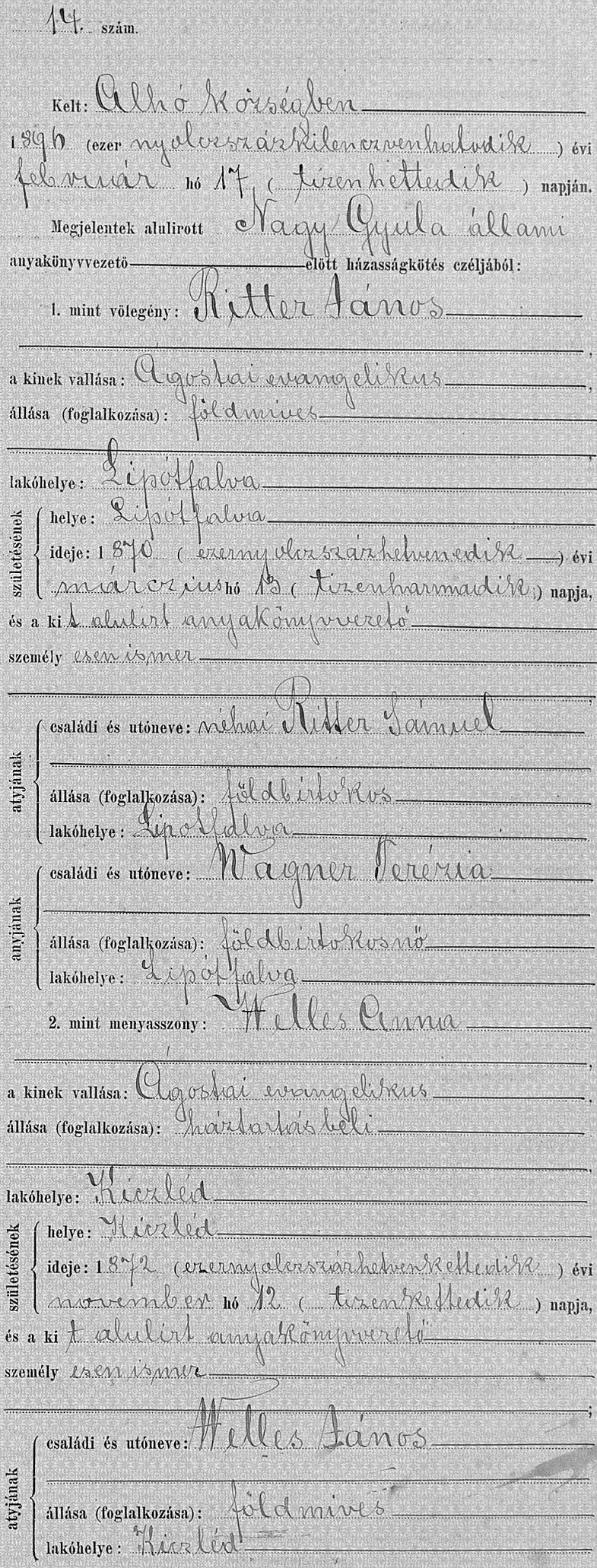 Translation: 14 number. [sequential record number in year] Dated: Alhó village [Markt Allhau] 1896 (thousand eight-hundred ninety-six) year February month 17 (seventeen) day. Appeared before Nagy Gyula state registrar for the purpose of marriage: 1. As a groom: Ritter János Religion: Augsburg Lutheran Position (occupation): Tiller of the soil / Agricultural laborer Residence: Lipótfalva [Loipersdorf] Birth [<- vertical text on left] Place: Lipótfalva Time: 1870 (thousand eight-hundred seventy) years March month 12 (twelvth) day. and whom the undersigned registrar personally knows Father [<- vertical text on left] Family and first name: the deceased Ritter Sámuel Position (occupation): Landowner Residence: Lipótfalva Mother [<- vertical text on left] Family and first name: Wagner Terézia Position (occupation): Woman landowner Residence: Lipótfalva 2. As a bride: Welles Anna Religion: Augsburg Lutheran Position (occupation): Homemaker Residence: Kiczléd [Kitzladen] Birth [<- vertical text on left] Place: Kiczléd Time: 1872 (thousand eight-hundred seventy-two) years November month 12 (twelvth) day and whom the undersigned registrar personally knows Father [<- vertical text on left] Family and first name: Welles János Position (occupation): Tiller of the soil / Agricultural laborer Residence: Kiczléd The first page of the record ends here. The second page (the back side of the first page) continues the record. Here is the image of the second page of the record (with a small part that actually appears in the margin of the page moved to under the page so I can present a bigger image):  The Translation continues: Mother [<- vertical text on left] Family and first name: Krutzler Erzsébeth Position (occupation): Homemaker Residence: Kiczléd Also appeared: 3. As a witness Böhm Sámuel whose position (occupation): Landowner residence: Lipótfalva age: 47 (fourty-seven) years and whom the undersigned registrar personally knows 4. As another witness Böhm János whose position (occupation): Master Joiner residence: Kiczléd age: 36 (thirty-six) years and whom the undersigned registrar personally knows [For clarity, the following four sentences do not follow the original line-by-line splits nor direct word order of the Hungarian text.] The undersigned civil officer declares that the marriage couple, in the presence of two witnesses, jointly and individually declared their consent to conclude a marriage to each other. The undersigned civil official, based on the joint consent of the spouses and according to the law, declares them married. Comment: The marriage ceremony in the Vas County Office of Clerk is released under the publication exemption waiver of 1896 year February day 4 number 4616 / 896. The wedding party does not read the Hungarian language but they understood and comprehended German. Confirmed and signed One witness signature (signature): The husband's signature (signature): Böhm Samu Johann Ritter Another witness signature (signature): The wife's signature (signature): Johann Böhm Anna Ritter born Welles Nagy Gyula Registrar The witnesses agreed with this first copy. Done at: Alhó 1896 year February month 17 day. Nagy Gyula Registrar [Most of these duplicate civil records have "s. k." after signatures, where "s. k." is an abbreviation for "saját kezűleg" (or something related) and means "by own hand." That was the copyist's way of indicating that, unlike the rest of the form, that line was not originally filled out by the clerk. The clerk and the copyist were often the same person, however.] I hope some of you find this useful. As separate articles, I provided similar line-by-line translations of an example "long-form" Hungarian civil birth record and of an example "long-form" Hungarian civil death record. I'll also note that Réka Keiß (who verifed and/or corrected my translations) tells me that the long forms are back in everyday use in Hungary, looking much like these versions from over one-hundred years ago! |
4) BERNSTEIN'S EDELSERPENTIN In Newsletter No. 222 (June 30, 2012), Richard Potetz and I wrote about the Amber Road and said in passing about Bernstein:
As I noted, serpentine is a basic magnesium silicate -- but other elements may also be present in small quantities,
including iron, chromium, nickel and cobalt, that alter its appearance and hardness. Most serpentine is translucent to
opaque and is fairly soft and light. Its luster can be greasy, waxy or silky. While it can be confused with nephrite
(Chinese) jade, nephrite is much harder, tougher and has a less greasy luster. |
5) HISTORICAL BB NEWSLETTER ARTICLES Editor: This is part of our series designed to recycle interesting articles from the BB Newsletters of 10 years ago. This one comes from the June 2006 issue (#152) and addresses the surname suffix "its" (and its variations). THE BURGENLAND BUNCH NEWS - No. 152B June 30, 2006 SURNAMES ENDING IN "ITS" AGAIN Correspondent writes: Do you know anything about the surname Zarahovits? Is that usually Jewish? Are all surnames that end in "vits" Jewish? Gerry's Reply: No, some surnames ending in "its" are Jewish, but not all. To understand this you must know something about how surnames have developed. Hebrew surnames are Hebraic in scope—biblical (the name given at birth). In the 14th & 15th centuries when surnames were required for common people, the Jews were not interested in giving up their Hebraic names (e.g., David ben Israel). They were forced to do so, many taking names of places they resided (e.g., Rosenberg), items in nature (e.g., Stern = star), etc. Those who did not assume a name were given one by the authorities. Some also took names similar to the non-Jews where they lived. In Slavic regions, they used the "son of - child of" method; "its", "vits", "ovich", "ovits" endings all mean "child of." Thus Zarahovits means descendant of Zarah. Many orthodox Jews in Christian countries still recognize two names—biblical and common. Most Burgenland Croatian names end in "its" but I have not encountered Zarahovits, thus it may well be Jewish. If Jewish, the Zarahovits may have come from the Balkans (Croatia) but they also may have come from Eastern Europe—Poland, Czechoslovakia, etc.—so-called Ashkenazi as opposed to the Spanish and Balkan Sephardic Jews. The only way to know for sure is to trace your family. If Jewish, you should certainly check out a Jewish website, getting back to us if you find your family also resided in the Burgenland area or in the Austro-Hungarian Empire. On the other hand, if your family is Roman Catholic, you should check a Croatian website. |
6) ETHNIC EVENTS LEHIGH VALLEY, PA Sunday, July 17: Reading Liederkranz Singers' Sommerfest. Music by DJ ÜberMeister. Info: www.readingliederkranz.com Sunday, July 17: Jägermeister Day at the Coplay Sängerbund. Music by the Josef Kroboth Orchestra. Info: www.coplaysaengerbund.com Sunday, July 24: 131st Stiftungsfest of the Reading Liederkranz. Entertainment by Mädel Jäger, the Edelweiss Schuhplattlers, and the Reading Liederkranz Singers. Info: www.readingliederkranz.com Sunday, July 31: Parish Picnic at Holy Family Catholic Church in Nazareth. Music by the Josef Kroboth Orchestra. Info: www.holyfamilynazarethpa.com NEW BRITAIN, CT Friday, July 1, 7 pm: Heimat Abend. Austrian Donau Club, 545 Arch Street, $3. Music by Joe Rogers and his band. Friday, July 15, 7:30 pm: Heurigan Abend. Austrian Donau Club, 545 Arch Street, $3. Music by Schachtelgebirger Musikanten. |
7) BURGENLAND EMIGRANT OBITUARIES Anne Schultz (née Muhr)  Anne M. Schultz, age 95, of Palos Hills, Illinois, at rest May 31, 2016. She was the beloved wife of the late Raymond Schultz; cherished mother of Joseph (Catherine) Spacucello and Robert (Madelene) Spacucello; loving grandmother of Jeffrey (Traci) Spacucello, and Lisa (Mario) Savoie; great-grandmother of Dominic, Gianna, Emerson and Ariana – all who were blessed to have her love and enjoy her 95th birthday this past year. Anne left her grandmother in her birthplace of Badersdorf, Burgenland, Austria at age 14, traveled alone by ship and train to live with her mother Anna and stepfather Joe in Chicago. She worked at the renowned Dressels Bakery in Chicago. Anne was a devoted parishioner of Sacred Heart Parish in Palos Hills. Among her many awards she received from the City of Palos Hills and Cook County for volunteerism and service to seniors, she was the recipient of the State of Illinois Governor’s Hometown Awards in 1990, 1993, 1995 and 1998. Anne loved her friends, Lake Katherine, knitting, cleaning, cooking, baking, puzzle books, and gardening. But most of all she loved her family, who will greatly miss her smiles, kisses and adoration. Visitation Sunday 2-8 p.m. Funeral Monday 9:15 a.m. from PALOS-GAIDAS FUNERAL HOME, 11028 Southwest Highway, Palos Hills, to Sacred Heart Catholic Church, Mass of Christian Burial 10:00 a.m. Interment St. Mary Cemetery, Evergreen Park, IL. For additional information (708) 974-4410 or PalosGaidasFH.com. Mary Strobl (née Marakovits)  Mary
"Mitzi" Strobl, 99, of Nazareth, Pennsylvania, passed away Monday, June 6, 2016 in Alexandria Manor. Mary
"Mitzi" Strobl, 99, of Nazareth, Pennsylvania, passed away Monday, June 6, 2016 in Alexandria Manor.She was the wife of the late John Strobl, who passed away October 10, 1976. Born July 30, 1916 in Edlitz, Burgenland, Austria, she was the daughter of the late Frank Sr. and Maria (Timar) Marakovits. Mitzi worked in the quality control department at Pioneer Sportswear, Nazareth and Hosiery Mill, Bangor. At 66 years old, Mitzi started volunteering at Gracedale for 24 years, and loved every minute of it. She loved her family, God and her Church. She was a member of Holy Family Catholic Church in Nazareth and was the President of the Altar and Rosary Society. She loved to dance and enjoyed polkas and waltzes. Mitzi was looking forward to her 100th birthday party this July; God will be throwing her a heavenly party now. Mitzi is survived by daughters, Dolores Unger and husband John, of Nazareth and Eleanora "Ellie" Darrohn and husband Samuel, of Allentown. Six Grandchildren: John Unger and wife, Sharon, Frank Unger and wife Patty, Chris Darrohn and wife Stephanie, Ann Schmidt and husband Art, Bob Unger and wife Karen, and Mike Darrohn and wife Angela. Six great-grandchildren: Caiti, Becky, Brielle, Rachael, Savannah and Amber. Sister, Rosina "Tina" Flank and husband John, of Stockertown. Many Nieces and Nephews. Pre-deceased by sister, Veronica Goth and brothers, Joseph and Frank Marakovits. Services will be Saturday, June 11, 2016 at 10:30 AM in the Joseph F. Reichel Funeral Home Inc., Nazareth. Followed by a Mass of Christian Burial at 11:00 AM in the Holy Family Catholic Church, of Nazareth. Burial in Holy Family Cemetery. Calling hours will be Saturday from 9:00-10:30 AM in the funeral home. Donations can be made to Dream Come True in c/o the funeral home. Online condolences may be offered at www.jfreichelfuneralhome.com Published in The Express Times from June 7 to June 8, 2016 Theresa Mayer (née Yandrisovits)  Theresa Y.
Mayer of Walnutport, Pennsylvania, formerly of Coplay, passed away peacefully with her loving family by her side on
Saturday, June 25, 2016 at the age of 97 at Lehigh Valley Hospital-Cedar Crest. Theresa Y.
Mayer of Walnutport, Pennsylvania, formerly of Coplay, passed away peacefully with her loving family by her side on
Saturday, June 25, 2016 at the age of 97 at Lehigh Valley Hospital-Cedar Crest.She was the loving wife of Edward I. Mayer, prior to his passing on May 1, 2007. They celebrated 65 years of a happy marriage on May 17, 2006, and has been patiently waiting for her since then. Born in Northampton, August 31, 1918, she was the daughter of the late Alois and Paulina (Ehrenhöfler) Yandrisovits. The family moved to Burgenland, Austria when she was three years old and she spent the next seven years of her early childrhood in Tudersdorf, going to school in Deutsch Tschantschendorf. Upon returning to American in 1928 she continued at Our Lady of Hungary School in Northampton. A member of St. Peter's Catholic Church, Coplay, she was a member of the Altar and Rosary Society for approximately 75 years. Theresa volunteered many years at the church picnic and baked her "Tessie Tasties" for special events and parish fund raisers. She also helped decorating the church at Christmas and Easter for the past 15 years. Mom was a member of the Coplay Saengerbund and Ss. Peter and Paul Society, Northampton. In her earlier years, she sang in the choruses of the Northampton Liederkranz and the Coplay Saengerbund. Later she enjoyed playing the organ for family and friends. A fabulous Mom who was always stylish, she was an excellent seamstress who created many of her own as well as her daughter's clothes over the years, well into her 70's. I not only lost my Mom, but my best friend. Theresa worked in the garment industry and was a dedicated employee for over 30 years at the D&D Shirt Co., Northampton, where they manufactured clothing for the armed forces in WWII. An excellent cook and baker, family and friends always looked forward to her gourmet Kipfels and tortes for holiday and family celebrations. Theresa and her husband Eddie were great polka fans and enjoyed dancing to their favorite bands. She continued to dance until the age of 95. They also loved to travel, especially with their daughter and son-in-law, visiting Europe, and her beautiful Austria many times, as well as Hawaii, Alaska and countless cruises. Her family will have thousands of wonderful memories of their happy times together. An energetic lady, she took her first Hot-air balloon ride with her daughter on her 90th birthday. Her family was her greatest joy. She had a heart of gold and will be dearly missed by all who knew and loved her, especially her family. Survivors: Daughter, Beverly Ann M. Sobchak wife of Michael Sobchak with whom she resided; many nieces and nephews. She was predeceased by her husband, Edward, and infant son, Edward Jr.; five sisters, Paulina Yandrisovits, Stephanie Hanzl, Pauline Rizzotto, Mary Babiak, Helen A. Rizzotto. Services: Viewing from 8:30-10:00 a.m, Thursday, June 30, Robert A. Hauke Funeral Home, 327 Chestnut St., Coplay followed by a Mass of Christian Burial at 10:30 a.m., St. Peter Catholic Church, 4 S. Fifth St., Coplay. Interment, parish cemetery, Whitehall. Contributions: To the church c/o the funeral home 18037. |
| END OF NEWSLETTER (Even good things must end!) |
NOTICE (Terms and Conditions): The Burgenland Bunch (BB) was formed and exists to assist Burgenland descendants in their research into their heritage and, toward that end, reserves the right to use any communication you have with us (email, letter, phone conversation, data upload, etc.) as part of our information exchange and educational research efforts. • If you do not want your communication to be used for this purpose, indicate that it is "confidential" and we will abide by that request. • Correspondents who communicate with the BB without requesting confidentiality retain their copyright but give a non-exclusive license to the BB allowing us to forward to BB members, publish in our monthly newsletter or on our website, and/or subsequently and permanently archive all or parts of such communications. The Burgenland Bunch homepage (website) can be found at: http://www.the-burgenland-bunch.org Burgenland Bunch Newsletter, copyright © 2016 by The Burgenland Bunch All rights reserved. Permission to copy excerpts granted if credit is provided. |
 News
News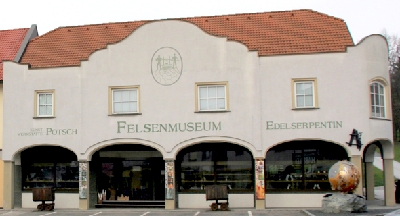 Unfortunately,
everything about our claim that "Bernstein is the world's only source of chrysolite serpentine" is simply wrong.
Serpentine is a hydrated magnesium silicate, usually green, yellowish-green, or brownish-green in color and deposits
are found in the mountain belts of many countries: USA, Canada, Italy, Greece, Afghanistan, UK, Austria, France, Korea,
China, India, and Myanmar. The name is derived from its serpent-like green colors. In German, the local version of
serpentine is known as Edelserpentin and creating art objects from it is a local craft. There is even a museum,
the Felsenmuseum (Rock Museum), largely dedicated to it in Bernstein.
Unfortunately,
everything about our claim that "Bernstein is the world's only source of chrysolite serpentine" is simply wrong.
Serpentine is a hydrated magnesium silicate, usually green, yellowish-green, or brownish-green in color and deposits
are found in the mountain belts of many countries: USA, Canada, Italy, Greece, Afghanistan, UK, Austria, France, Korea,
China, India, and Myanmar. The name is derived from its serpent-like green colors. In German, the local version of
serpentine is known as Edelserpentin and creating art objects from it is a local craft. There is even a museum,
the Felsenmuseum (Rock Museum), largely dedicated to it in Bernstein. 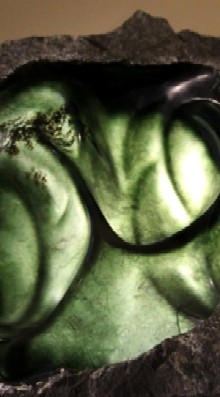 But
what is this Edelserpentin? Translating the word yields "noble serpentine," and the "noble" part appears to be
a local description referring to a particularly grade of serpentine. However, "noble" is also a generally-accepted
term among gemologists used to distinguish gem quality from less desirable stone (the term, "precious" is also used).
Further, serpentine is not just a gemstone but also a group of minerals that includes up to 20 different but related
members. And, regardless of the many varieties of serpentine, there are only two basic types of serpentine: antigorite
and chrysotile. So our claim that Bernstein has "chrysolithe serpentine" appears to be a spelling error: we
likely meant chrysotile, not chrysolithe.
But
what is this Edelserpentin? Translating the word yields "noble serpentine," and the "noble" part appears to be
a local description referring to a particularly grade of serpentine. However, "noble" is also a generally-accepted
term among gemologists used to distinguish gem quality from less desirable stone (the term, "precious" is also used).
Further, serpentine is not just a gemstone but also a group of minerals that includes up to 20 different but related
members. And, regardless of the many varieties of serpentine, there are only two basic types of serpentine: antigorite
and chrysotile. So our claim that Bernstein has "chrysolithe serpentine" appears to be a spelling error: we
likely meant chrysotile, not chrysolithe.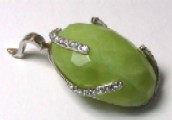 When
cut as a gem, serpentine usually has a highly polished, rounded or convex top with no faceting and is worn as earrings,
pins, pendants or brooches; use in rings requires a well-protected setting. Given its softness, most serpentine is, instead,
fashioned into decorative or ornamental gemstone carvings and figures, as is true for Bernstein's Edelserpentin.
When
cut as a gem, serpentine usually has a highly polished, rounded or convex top with no faceting and is worn as earrings,
pins, pendants or brooches; use in rings requires a well-protected setting. Given its softness, most serpentine is, instead,
fashioned into decorative or ornamental gemstone carvings and figures, as is true for Bernstein's Edelserpentin.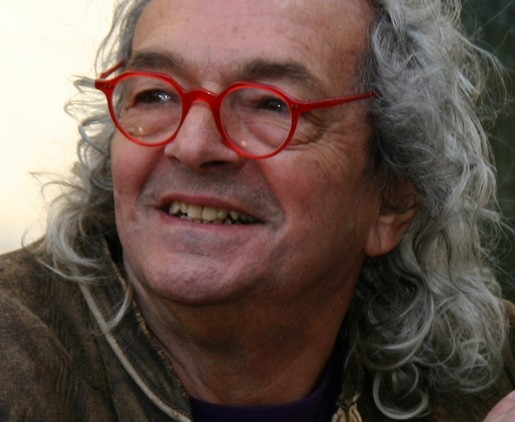 Otto
was born in 1938 in Vienna, where he trained with a distinguished ivory and amber sculptor. There he discovered and
developed his unique skills and his fondness for details. At age 19, he carved a “Chinese miracle globe” from ivory,
allowing him to discover the ancient secrets of Asian ivory sculptors. At age 21, he passed his examination and obtained a
master craftsman’s certificate. In 1966 he opened his first art workshop and started to work with Edelserpentin,
being especially fond of creating animal sculptures. In addition to his work with Edelserpentin and amber, Otto also
experimented with painting and music and he began to collect scrap metal that he could shape into sculptures with a torch
and other forge implements. He has since become an acknowledged Edelserpentin and amber expert in Austria.
Otto
was born in 1938 in Vienna, where he trained with a distinguished ivory and amber sculptor. There he discovered and
developed his unique skills and his fondness for details. At age 19, he carved a “Chinese miracle globe” from ivory,
allowing him to discover the ancient secrets of Asian ivory sculptors. At age 21, he passed his examination and obtained a
master craftsman’s certificate. In 1966 he opened his first art workshop and started to work with Edelserpentin,
being especially fond of creating animal sculptures. In addition to his work with Edelserpentin and amber, Otto also
experimented with painting and music and he began to collect scrap metal that he could shape into sculptures with a torch
and other forge implements. He has since become an acknowledged Edelserpentin and amber expert in Austria.